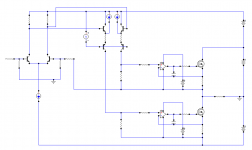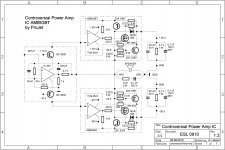Kanwar,
effebi,
are you reading this? But after the VAS we need a thin pipe, a very high and steady pressure. For this reason and for every other reason, it has to be a FET. It is more about plumbing than computation.
Seemingly, you are losing your patience with this issue of central importance. Again, the low input impedance of the common base amplifier ensures nearly ideal conditions for transfer of current. Why on earth would you (and D. Self) make it worse?For impedance matching issues, Kindly start a new thread , this was our lovely VAS discussion thread guys
effebi,
are you reading this? But after the VAS we need a thin pipe, a very high and steady pressure. For this reason and for every other reason, it has to be a FET. It is more about plumbing than computation.
But after the VAS we need a thin pipe, a very high and steady pressure. For this reason and for every other reason, it has to be a FET. It is more about plumbing than computation.
...and it is the reason why Bob Cordell's amps sound so different: they isolate output from first stages better than other amps. Driver needs just enough of power to deal with capacitances that reflect load better on higher frequencies, but bass is magnificent!
Member
Joined 2009
Paid Member
My favourite is a BD139, because that's all I've used so far; I haven't found it to be a limiting factor in the amplifiers that used it. It's obtainable from more than one source, appears popular enough to suggest it's be around a few more years.
What I haven't tried and actually would like to try very much is.... a step-up transformer follwed by a JFET source follower.
by the way, You guys got one more month to sort out your fav VAS transistor - or we'll have to open a new thread "it's 2011 whats your...." 😀
What I haven't tried and actually would like to try very much is.... a step-up transformer follwed by a JFET source follower.
by the way, You guys got one more month to sort out your fav VAS transistor - or we'll have to open a new thread "it's 2011 whats your...." 😀
Wavebourn,
with FETs, the pressure falling only at very high frequencies, the high and constant pressure allows a linear and forceful transmission. Of course, it also promotes low distortion in the VAS.
with FETs, the pressure falling only at very high frequencies, the high and constant pressure allows a linear and forceful transmission. Of course, it also promotes low distortion in the VAS.
Wavebourn,
with FETs, the pressure falling only at very high frequencies, the high and constant pressure allows a linear and forceful transmission. Of course, it also promotes low distortion in the VAS.
Agree.
Here is what I did to deal with non-linear MOSFET capacitances:

Member
Joined 2009
Paid Member
Wavebourn, I see your genius again. That U1 thingy, is it really doing something clever with the supply (instead of using a large cap) ?
nice use of ngb at the output there.
nice use of ngb at the output there.
Last edited:
Wavebourn, I see your genius again. That U1 thingy, is it really doing something clever with the supply (instead of using a large cap) ?
nice use of ngb at the output there.
Thanks; if MOSFET thinks of itself as a charge controlled device, so feedback across it should be capacitive, right? Such a way it is turned to a charge controlled triode.
that U1 thingy precisionally sets idle current of an output stage. Output voltage is set by R1 and R2.
Last edited:
Kanwar,
Seemingly, you are losing your patience with this issue of central importance. Again, the low input impedance of the common base amplifier ensures nearly ideal conditions for transfer of current. Why on earth would you (and D. Self) make it worse?
Isn't the thread is "Fav VAS transistor", i think the discussion must centre around selecting best device, for "impedance transformations" we can start another thread with more vital discussions indeed.😉
I am not making it worse, i just favor discreetness of the issue.😎
Kanwar
@Wavebourn,
I did a similar thing in my N-channel Mosfet Amplifier using opamp as VCCS, have a look.😉
Looks similar, but mine was a single ended triode output amp, with capacitive feedback divider, while yours is a current source push-pull amp. In my amp an idle current only is regulated such a way.
Isn't the thread is "Fav VAS transistor", i think the discussion must centre around selecting best device, for "impedance transformations" we can start another thread with more vital discussions indeed.😉
I am not making it worse, i just favor discreetness of the issue.😎
If you want to limit selection of the device for some certain topology, just say that. If not, let's be open and more flexible in discussing devices for topologies, and topologies for devices.
Consensus?
Last edited:
If you want to limit selection of the device for some certain topology, just say that. If not, let's be open and more flexible in discussing devices for topologies, and topologies for devices.
Consensus?
I am not against discussion of topologies, for that we can have a new thread, whatz wrong in that?
because the title of this thread is misleading for having discussions on topologies.
Last edited:
Looks similar, but mine was a single ended triode output amp, with capacitive feedback divider, while yours is a current source push-pull amp. In my amp an idle current only is regulated such a way.
Yeah, mine is voltage controlled current source configured which also takes care of non linear gate capacitance along with thermal drift.
Last edited:
Yeah, mine is voltage controlled current source configured which also takes care of non linear gate capacitance along with thermal drift.
Yes, brute force across multiple stages of opamp with 10 Hz corner frequency. I had a different thing in mind: local feedback across output device only. Both approaches work. Differently. 😉
I am not against discussion of topologies, for that we can have a new thread, whatz wrong in that?
Nothing is wrong, except for which one topology do you want to discuss the best VAS device?
Nothing is wrong, except for which one topology do you want to discuss the best VAS device?
I think the thread starter is referring towards normal version of CE VAS, the regular one found in many amplifiers after differential input stage. But i was never into discussing topology as far as the thread name goes.
Last edited:
I think the thread starter is referring towards normal version of CE VAS, the regular one found in many amplifiers after differential input stage. But i was never into discussing topology as far as the thread name goes.
Why do you think the thread has 28 pages, and nobody still agreed? Because the topic is undefined, and everyone has in mind own topology...
Why do you think the thread has 28 pages, and nobody still agreed? Because the topic is undefined, and everyone has in mind own topology...
No Offense, for me the thread has 6 pages only not 28, might be due to 50 posts per page setting.😀😀
Last edited:
Hi, Workshoe
That's good one, using floating drivers are the best for driving mosfets, easily reach 5A peak curent to drive several big mosfets that is very hard job for non floating supply. Use something stronger than opamps to get its advantages.
And..... in this case, my favorite is 2SC3355 and ksp2222A
Is there available 100 post per page?
My firefox is fully enhanced and I have enough memory here.🙄
That's good one, using floating drivers are the best for driving mosfets, easily reach 5A peak curent to drive several big mosfets that is very hard job for non floating supply. Use something stronger than opamps to get its advantages.
And..... in this case, my favorite is 2SC3355 and ksp2222A
No Offense, for me the thread has 6 pages only not 28, might be due to 50 posts per page setting.😀😀
Is there available 100 post per page?

My firefox is fully enhanced and I have enough memory here.🙄
Hi, Workshoe
Is there available 100 post per page?My firefox is fully enhanced and I have enough memory here.🙄
First of all its Workhorse.....!!!😡😀
I think 50 posts is the limit.....
My favourite VAS driver is THS4631.😀
Nice driver, Kilovolt per microsecond. And the amp should sound like tube amp with pentode outputs. 😉
- Home
- Amplifiers
- Solid State
- It's 2010 and what's your fav VAS transistor?

